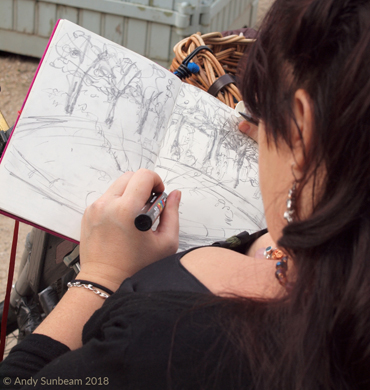"I love my sketchbooks," says Jane Sunbeam, "They are places to continually improve my observational drawing, to doodle ideas, to record holiday memories, or, accidentally, to create final artworks in - which leaves me with the dilemma of how to extract the piece from the book with minimal damage. I am an avid collector of sketchbooks, all different shapes, sizes and paper weight. My favourites are small A6 ones, and I try to carry one with me at all times so that I am ready to capture a really interesting pose, an architectural detail, doodle ideas, or even write notes for a new story. They all go in there!"
Why do you use sketchbooks?
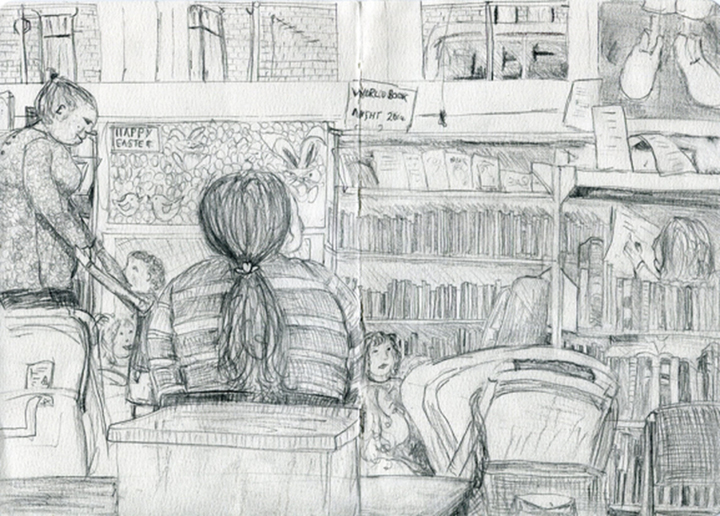
Jane Sunbeam, 'Toddler Time', sketchbook study
Sketchbooks are important to me for a number of reasons. They used to be a storage place for ideas, doodles and almost acted as a repository for occasional drawings, but I never fully used them as I do now. Now I feel lost without at least one of them by my side and I use my sketchbook each and every day.
I find them invaluable for keeping track of drawings, process and ideas. If I don’t have it with me, I feel lost, and end up scribbling things on pieces of paper which in turn are stuck in my sketchbook for safe keeping.
Why did you start using sketchbooks this way?
The change happened when I was studying for my MA in Children’s Illustration. Our first module was’ Observation and Experiment’ and it was 12 weeks of observational drawing.
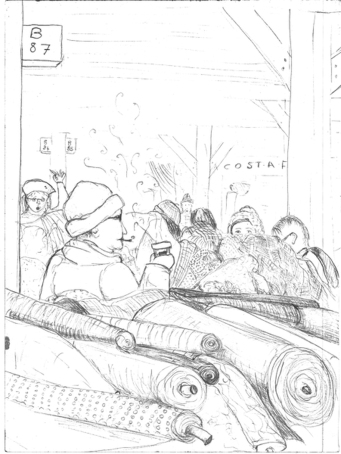
Jane Sunbeam, 'Fabric Man 1', sketchbook study
I began to draw EVERYWHERE and whenever I could – from Leicester Market, to a friend’s allotment, to my own house and various museums and galleries. At that point I still didn’t fully understand this need to observe and how it would impact my work.
My first observational drawings were rough and scribbly – but with practice I learnt to refine my hastily drawn lines into pieces that I felt happy with, and my process of understanding began. Then, in my second year I wrote an essay entirely about sketchbooks – and my fascination grew into the love that I have now.
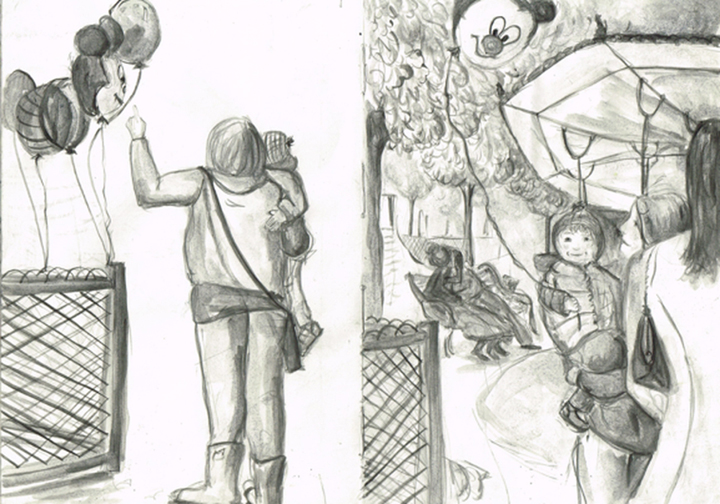
Jane Sunbeam, 'Happiness is a Balloon', sketchbook study
I explored the sketchbooks of Henry Moore, Ronald Searle, Shirley Hughes, E.H. Shepherd and Frida Kahlo. I examined the lengths that some went to in order to produce and keep such sketches, as Searle did when he was imprisoned in a prisoner of war camp (To the Kwai and Back: War Drawings 1939 – 1945), and sketchbooks of favourite illustrators such as John Vernon Lord, Catherine Hyde and Jackie Morris, as well those of my tutor Pam Smy, whose pen and ink drawings are unrivalled in my eyes.
This essay helped me realise that there was no “right” or “wrong” way of creating a sketchbook, and that the most important thing to do was to draw in them. That, and this little gem of insight from 15th century painter Cennini have kept me drawing ever since:
“Do not fail to draw something every day, for no matter how little it is, it will be well worthwhile and will do you the world of good.”
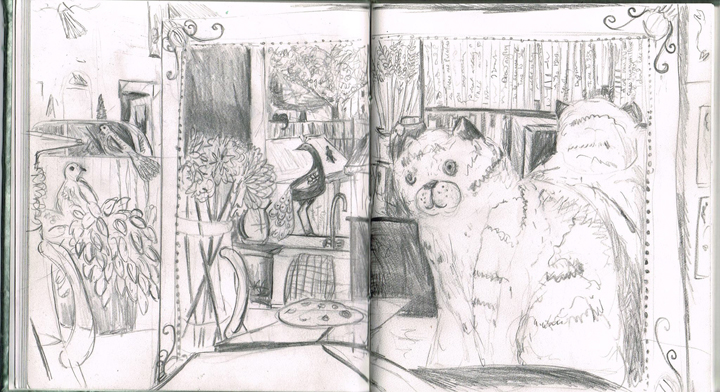
Jane Sunbeam, 'Mog in Studio', sketchbook pages
Now, it is an addiction….. I need to record the world, and I want to record my little insights. It helps me make sense of so much, and tbh when I draw imaginatively, the images flow forth as I have the understandings of the mechanics of drawing – I often liken doing observational drawing to a musician practising scales – they too assist with understanding how a key works and also helps assist with the ease of moving fingers.
How long have you been using sketchbooks?
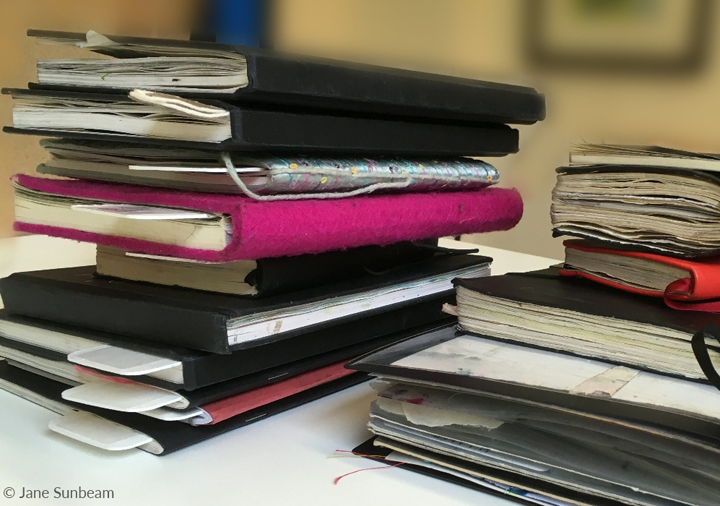
Jane Sunbeam, sketchbooks
I have used them on and off for many years, since first being a student over 20 years ago, and have dozens of A6 sketchbooks that I have filled over the years, and the odd larger one used in studies. However, since my MA, I use them all the time.
They are my ever-constant companions, pages open ready to be drawn in, a holder of dreams and ideas, and a repository of knowledge.
Are you organised in your approach, or more random?
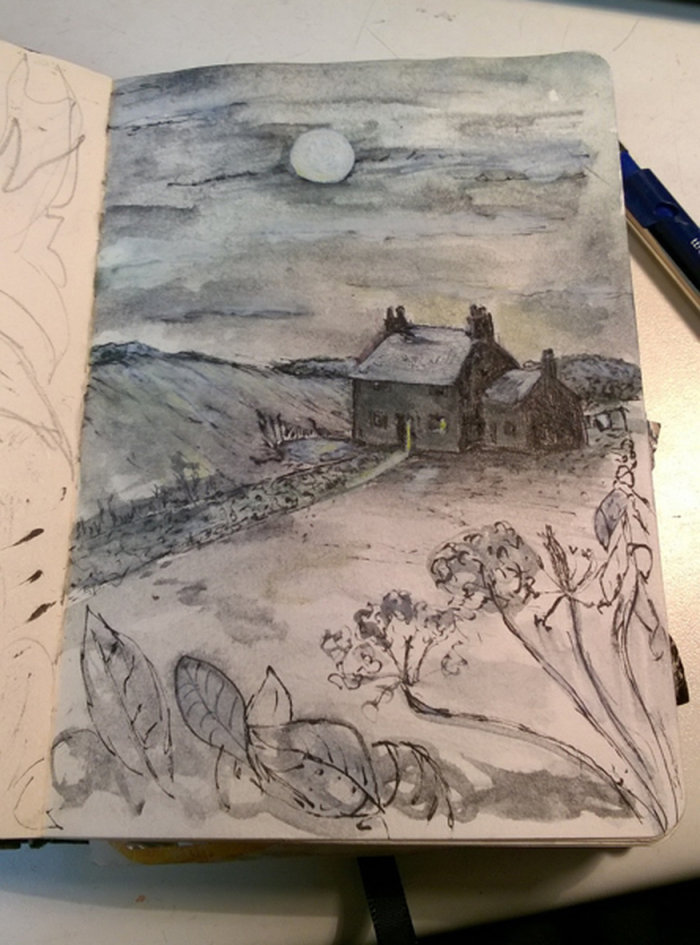
Jane Sunbeam, 'Nighttime Dreams', sketchbook
I use both approaches in my sketchbooks. In my more “private” sketchbooks, I am extremely random, and never use pages in successive order, and simply open the book and start drawing. This can be frustrating, as I need to rifle and rummage through the pages to find a specific image, but it is done deliberately, as it keeps me looking through the book, revisiting ideas, analysing drawings and often new work arrives through the glimpse at a forgotten page.
In contrast, when working on a specific project I will use dedicated sketchbooks and will work more methodically through the book so one can see the progression of work and ideas.
Do you have themes in your sketchbooks?
I suppose I will always have themes in my sketchbooks, as they will reflect what I am working on at the time and have dedicated sketchbooks for these times. For example, I am Artist in Residence at Leicester Print Workshop for the next three months (April ’18 – June ’18).
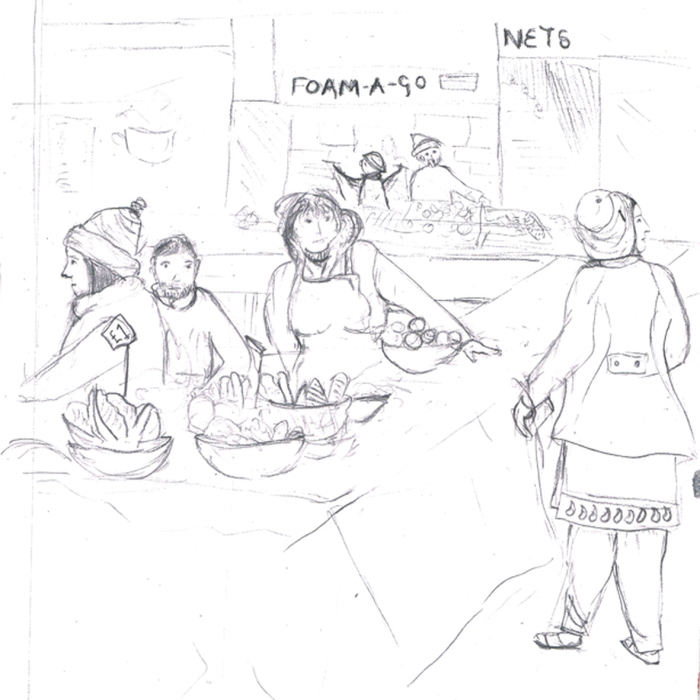
Jane Sunbeam, Leicester Market Sights 1', sketchbook study
I am basing new prints and ideas on observational drawings of Leicester Market which is in turn inspired by the work of narrative work of French illustrator Suzanne Balkanyi and so my sketchbooks for this will be filled with notes on her work, and my researches from her plates and my own drawings from Leicester market and hastily jotted-down conversations I will hear as I sit and sketch in the market.
Alongside these dedicated sketchbooks I also have small A6 ‘everyday’ sketchbooks which are much more mixed – and a sketch from a country walk will sit next to a swiftly sketched portrait drawn in the middle of a city which in turn sits next to a quote a poem, a piece of text or notes from a workshop. I like seeing them all mingle and that convergence is where my imagination takes over and the creation of my prints begin.
Does everything go in, or are you selective?
In my A6 sketchbooks everything goes in – from meeting notes, to important things to remember, and from messy, barely drawn sketches to careful studies of people and surroundings. I even have plots for books written in them…with character studies and twists and turns. I had a scary time a while back when I thought I had lost a specific sketchbook as I realised that everything I had written in the last year was stored in this little book, so I now photograph the odd crucial page too.
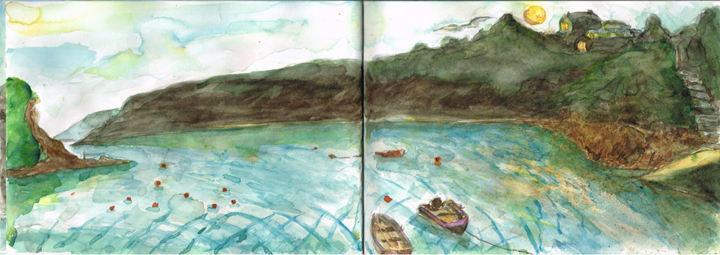
Jane Sunbeam, 'Solva', double sketchbook spread
My larger sketchbooks are less personal – with just sketches, drawings, and paintings in it, as I am always aware of the person looking over my shoulder as I draw, but the odd scribbled note does creep in. Also, find that if I go too big, I want to create finished pieces, which then poses the problem of how to extract them as there is often an equally loved image on the other side and so I have to decide which to sacrifice, which has happened on a couple of occasions.
How many sketchbooks do you have on the go at the moment?
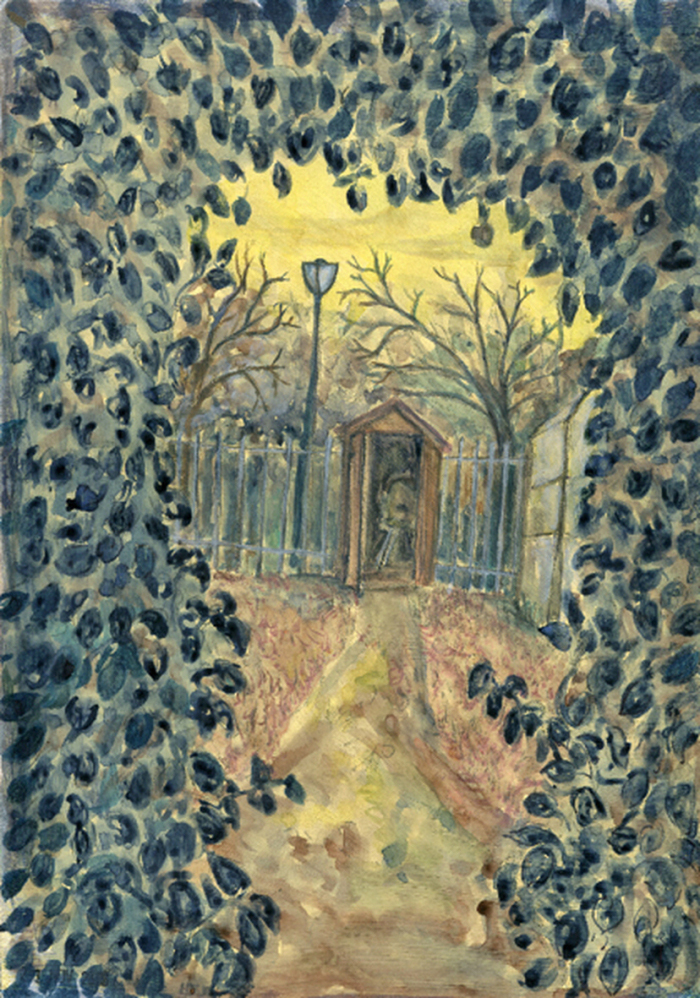
Jane Sunbeam, 'The Secret Allotment', sketchbook study
Gosh, that’s a question. I think I have five…. That seems like a lot, but the sizes range from A6 to A5 to A4 square and some are taken with me everywhere, and others were used for life drawing and portraiture.
Also, when I work from a sketch to develop an idea, I work in another sketchbook, and then from that work it up to a third. So these sketchbooks become companions to each other, one sketchbook split into three volumes.
What is your favourite sketchbook at present?
For me it has to be a Seawhite’s sketchbook… all their sketchbooks, no matter what size use 140gsm All-Media Cartridge Paper, which seems to take all different media well, doesn’t buckle much, and is beautiful to draw on too. They are a leading supplier of sketchbooks to educational establishments, and I started using them on my degree back in the 90’s and amassed quite a collection whilst at on my MA.
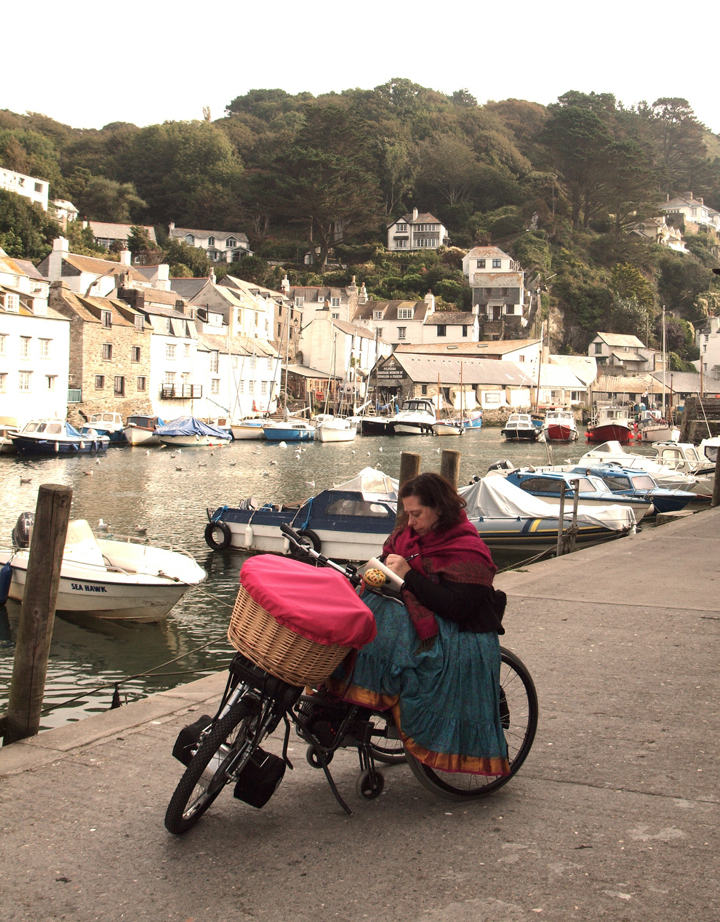
Jane Sunbeam sketching
I like their softback books – classed as “starter books” as they are not too thick, with only about 40 pages, but all this makes them ideal for carrying around with me when sketching (my poor electric bike batteries don’t like it when I pile it high with heavy sketchbooks). And as they are not too thick, they are easy to fold out and use for larger drawings, the paper being thick enough to balance on my handle bars and not collapse.
I do have other sketchbooks too…. many that I have collected from my travels and others given as gifts by friends and family and some I have made myself. Many I have used, others I merely put on my bookshelf and wait for that “perfect” project to use it….. it's very full shelf. . . .maybe it is the perfect time to use them!
What size works best for you and why?
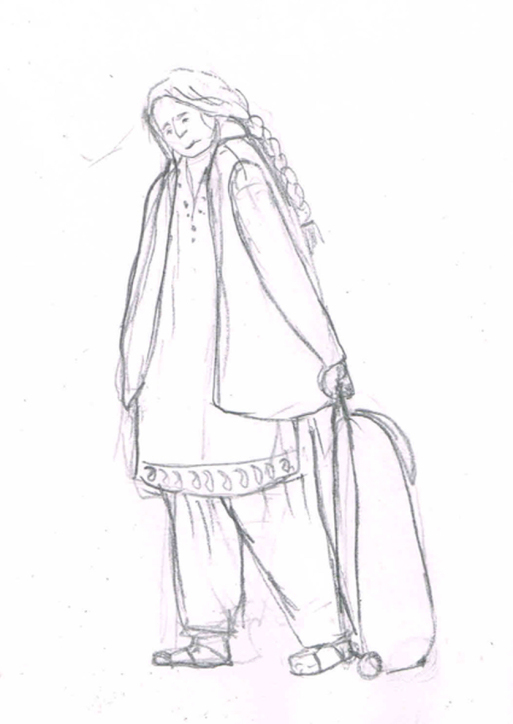
Jane Sunbeam, 'Heavy Trolley 1', sketchbook study.
My ideal size is A6 – it is so discreet to draw in – I love it, and as I have mentioned, it is the size I carry around with me at all times. However, for creating work in, it is not ideal at all, as it is hard to fully work through an idea on such a small scale, so I then turn to my A5 sketchbooks with their cross-referencing.
But for observational drawing I do feel that A4 is a vital tool too - although I do feel awfully self-conscious drawing this big, but I am hoping to challenge myself a great deal more in this residency.
What media do you use in your sketchbooks?
In my smaller sketchbooks and when out sketching I use pencil – I have tried to be organised to carry a multitude of brush pens and watercolour brushes, but the pencil always wins – not necessarily because of convenience, but because I love focussing on line work and mark making.
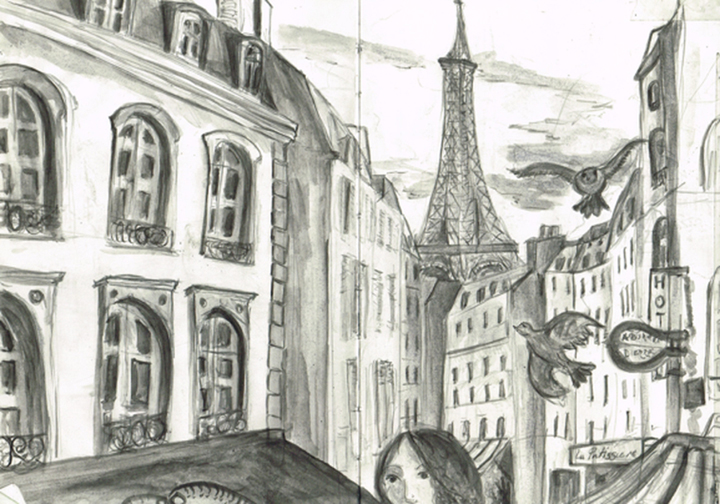
Jane Sunbeam, 'Paris street scene', sketchbook study, pencil
There is something sensitive in pencil lines that I like….and the challenge of making an interesting drawing using this one medium. For many years I felt as if I “should” be drawing in other ways, bringing out pots of paint (I did try that when drawing at my friends allotment, and it was ok, but not right for the middle of a city) but upon discovering Suzanne Balkanyi’s beautiful etchings based on daily life in Paris, which are primarily line based, I feel much more confident in my approach.
However, when working up ideas in my larger sketchbooks, anything goes, from watercolour, to pencil, to collage. I also learnt on my MA about creating grounds for my sketchbooks, which entailed using lots of tester pots of household emulsion in varying tones and colours and a hairdryer. I would simply sponge on the paint and use the hairdryer. And would sometimes fill half a sketchbook this way before using it.
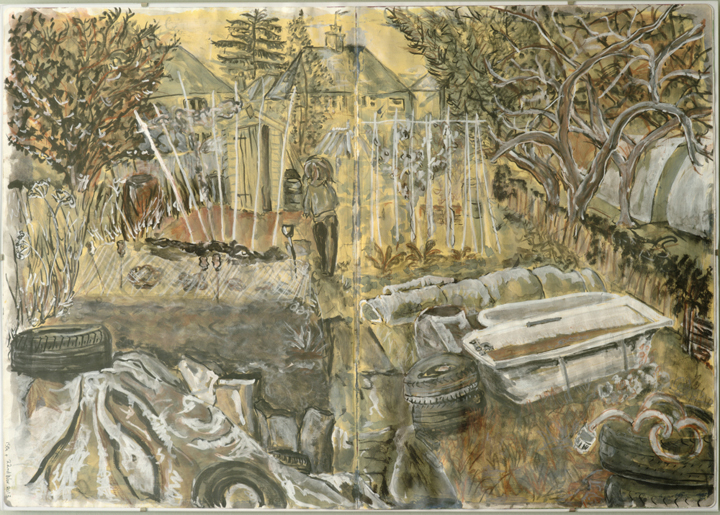
Jane Sunbeam, 'Ruth's Plot', sketchbook double spread
Why do this? Well, it seals the pages, so they were more robust, and paint sits on the top, and could be manipulated more – this is ideal for those with sketchbooks containing thinner paper. Also, it creates a base tone, so I could add darker and lighter tones in a more experimental way – it was perfect for experimentation.
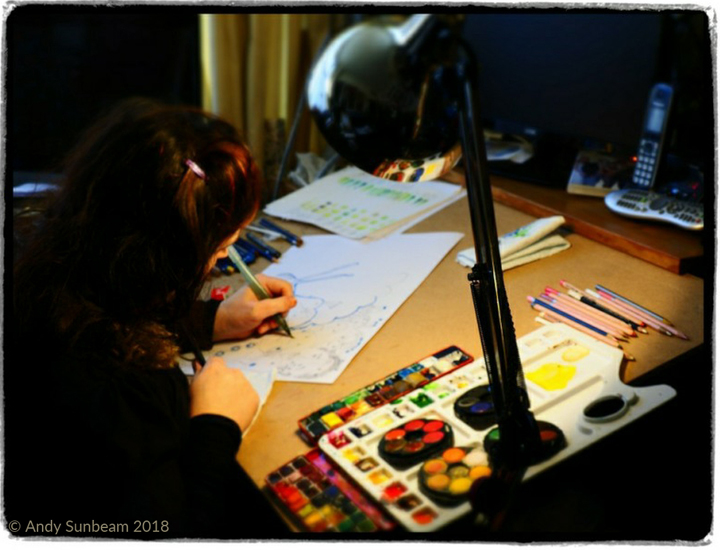
Jane Sunbeam developing ideas (photo: Andy Sunbeam)
I also love Daniel Smith’s watercolours – they granulate exquisitely, and you can buy a set of sample sheets containing a “dot” of all 238 colours and are ideal for experimenting.
What’s your favourite pencil or pen to use in your sketchbook?
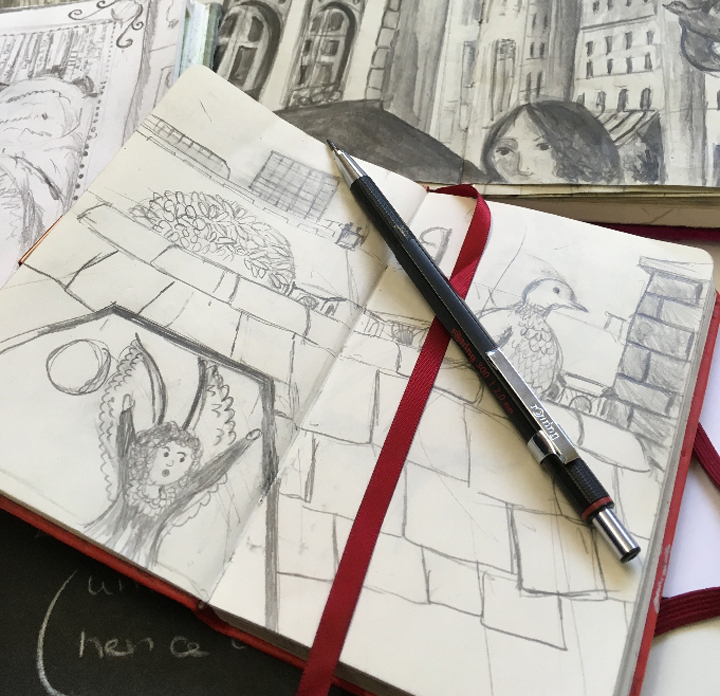
Jane Sunbeam's A6 sketchbook and Rotring 300 pencil
My absolute favourite for sketching is my Rotring 300 propelling pencil with built in sharpener. The leads are as thick as a pencil, but much more robust. And I have recently discovered great quality, oil based coloured leads for it too, so it means I have access to over 20 colours with only one pencil – perfect for carrying around with me!
But, a close second for drawing and finished work is the Palomino Blackwing Pencils – they are the most beautiful pencils I have ever drawn with. They come in three different grades, from soft to hard, with a fabulous, almost never-ending rubber. The only drawback is they only come in packs of 12 – but I got over that hurdle by swapping with two other friends – so now I have a full collection.
Is there anything you wouldn’t put in a sketchbook?
Basically, anything I wouldn’t want anyone knowing if I lost it. There is always the chance too that at some point a publisher may want to look through them, or a gallery, so I don’t want anything in there that would make me feel uncomfortable.
What’s the best thing about having a sketchbook?
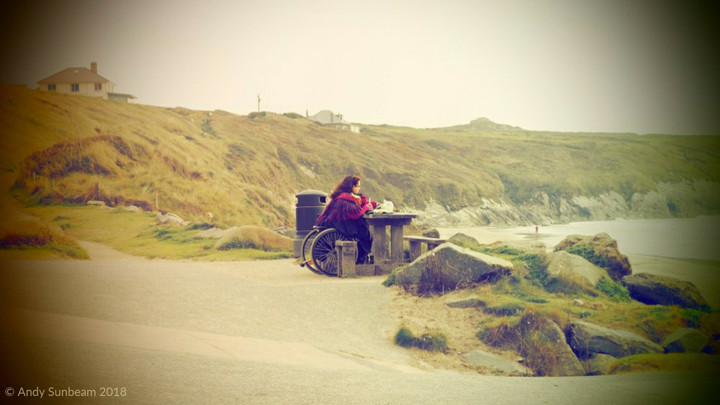
Jane Sunbeam sketching in Wales (photo: Andy Sunbeam)
The best thing for me is that they are places to escape to – I struggle greatly with pain, and when I am drawing in my sketchbook, the focus on looking and recording is a sort of meditation, and the pain vanishes for a while.
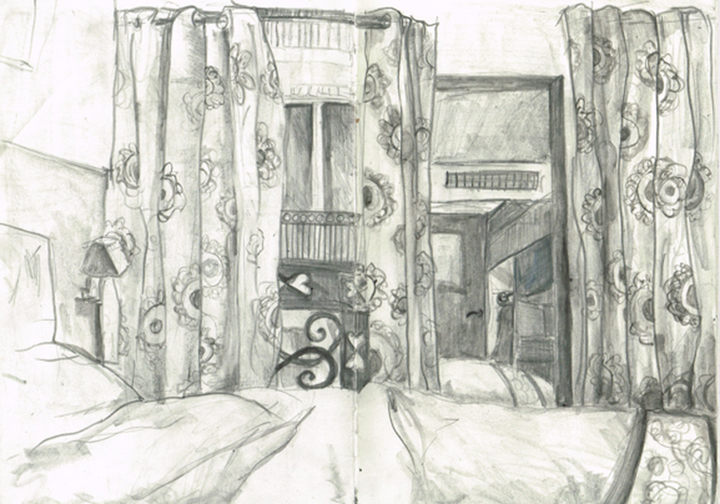
Jane Sunbeam, 'Paris Room 1', sketchbook study
But out of that looking comes the second best thing – they are a visual diary of my life – of the holidays I went on, of the changes in the world, in the changes in my life. They are places to play hide and seek, to make friends with characters, to record a tender moment, and somewhere to allow myself to play freely with materials without judgement.
I love this quote from illustrator John Vernon Lord, where he discusses so eloquently his use of sketchbooks – I think it sums it all up so perfectly:
"Drawing for me is trying to visualise and bring to life the ideas and range of interpretations that lurk like misty visions inside my head = the composing, the fumbling and stumbling; the sorting out of marks; the rubbing out; the hesitations; the adjustments; the decisions; the hopes and anticipation; the heartache; the overcoming of weaknesses; the taking of risks; coping with and taking advantage of unexpected developments that may arise; gathering of strengths; getting the desired expression and mood; establishing content; inventing new worlds and the whole process reaching towards a visual conclusion."
John Vernon Lord', Drawn to Drawing'
The sketchbooks of Jane Sunbeam are on display at Cank Street Gallery, 44-46 Cank Street, Leicester LE1 5GW - more about this coming soon.
Useful Links
Jane Sunbeam - under the 'Artist' section on our website
www.janesunbeam.com - Jane Sunbeam's own website
www.cankstreetgallery.co.uk - Jane's sketchbooks currently on show here
www.leicesterprintworkshop.com - LPW Artist in Residence, Jane Sunbeam
